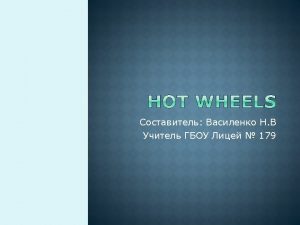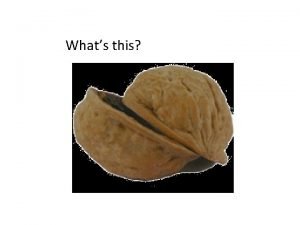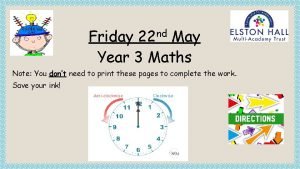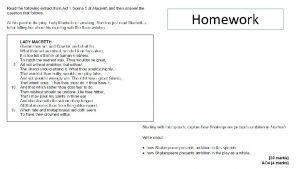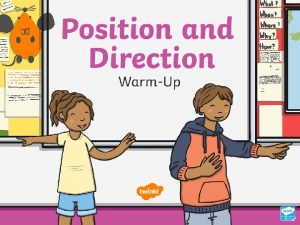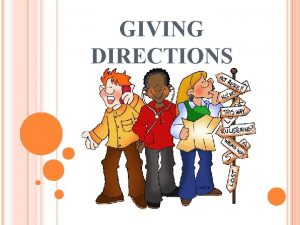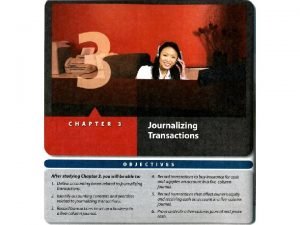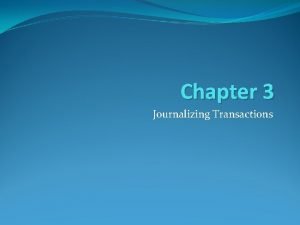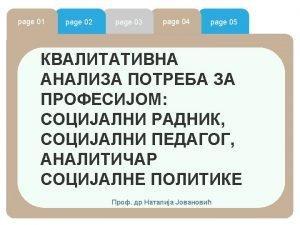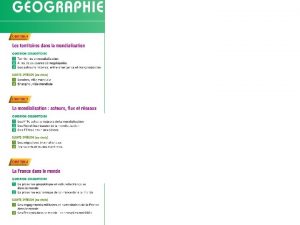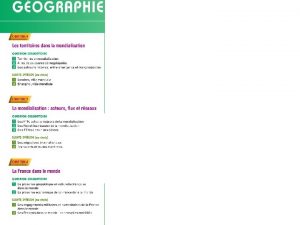Turn to page 3 in journal and title















- Slides: 15

Turn to page 3 in journal and title it : Bell Work 18/10/16 1. 2. 3. 4. 5.

Objetivo • We will learn the verb Ser and how to conjugate and use it. • I will have a new Tarea sheet and practice with activities 1 -4 in the book. • Success Criteria • Have your pencil and paper ready with new Tarea Sheet. • Participate in class activities.

Subject Pronouns: lunes, 17. 10. 2016 What pronouns would you use to speak about the following people? 1. Two female teachers from PHS Ellas 2. Your best girl friend Ella 3. Sr. Wrinkle Él 4. The Dallas Cowboys Ellos 5. You and Dr. Sheldon Cooper Nosotros

Camapana #7 fecha: 18 de septiembre dia: viernes Translate the following sentences into Spanish. Use SER notes. Write the Spanish sentence only. ex. He is my friend Juan. Ėl es mi amigo Juan. Ella esis mimy mejorbest amiga. friend. 1. She Nosotras somos are de losfrom estadosthe unidos. 2. We (fem. ) United States. Ellos son de Cuba. are from Cuba. 3. They (masc. ) ¿De dóndeare eres? you from? . 4. Where Él esis estudiante. 5. He a student.

EL VERBO SER = to be Sr. Castro - Español 1

¿Qué es conjugating? • In Spanish, a verb has different forms to tell you who the subject is. • Changing a verb form so that it matches its subject is called conjugating. ¡Aqui vamos! Here we go!

El Verbo Ser – to be yo soy – I am nosotros(as) somos – we are tú eres- you are (informal) él es ella es Usted es he is she is you are (formal) ellos son – they are (males/mixed gender) ellas son – they are (females) ustedes son –you all are

Más sobre el verbo ser • Remember that Spanish speakers sometime leave out the subject pronoun. – Es de Chile. He is from Chile. • To make a sentence negative or opposite, place a no BEFORE THE VERB – Soy de honduras. – No soy de estados unidos.

¡Vamos a practicar! 1. Nosotros somos. estudiantes y profesores del club de español. 2. Yo soy de Honduras. 3. Juan Emilio es de Venezuela. 4. Tú eres de Pflugerville High School. 5. El teléfono de Sra. Ramirez es el 512. 666. 9149. 6. Lisa y Rebecca son de España.

Más practica con ser Juan is conducting today's meeting of the Spanish Club. Match the phrases in the left and right columns to complete his conversations. 1. Hola. Yo D. 2. Hoy. F 3. Son las H. 4. Nosotros. G 5. Magdalena E. 6. Fánor y Elio A. 7. ¿De dónde B ? 8. Y tú, Alfredo, ¿ C ? a. son de México b. es la profesora Jalil c. de dónde eres d. soy Juan Quintero e. es de Perú f. es martes g. somos estudiantes de español h. cuatro y media

Ser Video • https: //www. youtube. com/watch? v=w 6 Tjef. G xf. PY

Finish Project Presentations

Capitulo 1 pronouns y ser Crossword Puzzle

Punctuation Marks and Accents • Upside down punctuation marks such as (¿) and (¡) are placed at the beginning of a phrase – Used to signal a question or exclamation • Also, when learning new words memorize where the accents are. – Adiós – ¿Cuál?

¡Practica! Rewrite the following words and phrases in lowercase, adding accents, tildes, and punctuation as needed. 1. ADIOS SENOR __________________ ¡Adiós señor! ¿Y tú? 2. Y TU _________________________ es él? 3. QUIEN ES EL ¿Quién _____________________ ¿Qué día es hoy? 4. QUE DIA ES HOY ___________________ mañana. 5. HASTA MANANA Hasta ___________________ 6. QUE TAL ¿Qué ______________________ tal? 7. COMO SE LLAMA EL __________________ ¿Cómo se llama él? ¿Quién es la muchacha? 8. QUIEN ES LA MUCHACHA ________________ ¿De dónde eres? 9. DE DONDE ERES ___________________ ¿Cuál es tu teléfono? 10. CUAL ES TU TELEFONO _______________
 Writing and completing reports and proposals
Writing and completing reports and proposals Apa title lage
Apa title lage Tomato flames
Tomato flames You can't turn right here. you turn left
You can't turn right here. you turn left Wash your hands put on your nightgown analysis
Wash your hands put on your nightgown analysis Answer. go straight turn left turn right
Answer. go straight turn left turn right Turn the arrow 1/4 turn clockwise
Turn the arrow 1/4 turn clockwise Is banquo macbeth's cousin
Is banquo macbeth's cousin Macbeth seeing banquo's ghost quote
Macbeth seeing banquo's ghost quote The picture means 1- go straight 2- turn right 3- turn left
The picture means 1- go straight 2- turn right 3- turn left Turn hell hound turn
Turn hell hound turn Put your right hand in the air
Put your right hand in the air Walk straight and turn left.
Walk straight and turn left. Turn to page 54
Turn to page 54 A form describing the goods or services sold
A form describing the goods or services sold A form for recording transactions in chronological order
A form for recording transactions in chronological order



